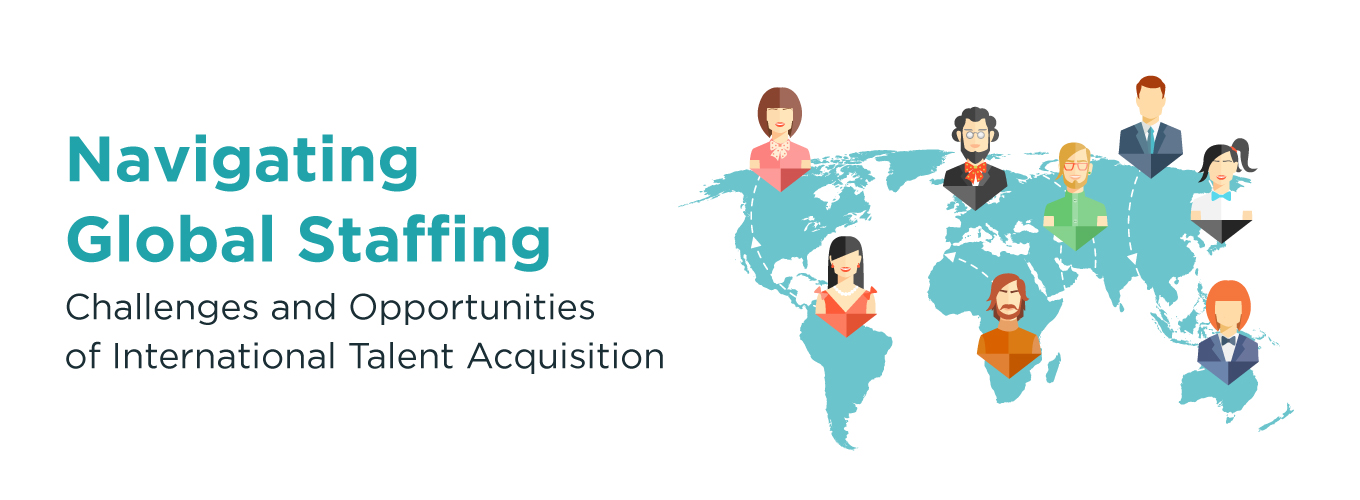Navigating Global Staffing: Challenges and Opportunities of International Talent Acquisition
In today’s recruitment landscape, many companies are multinational and are recruiting people who can travel and relocate to another country. Several companies are looking for international employees, who have the know-how, expertise, flexibility and open-mindedness. This is because in the context of globalization, teams must adapt to the new needs of customers and markets. Employees who are bilingual and know several markets are an asset for an international company. Especially when expanding businesses, a foreign employee can bring new ideas and different perspectives to the table.
However, venturing into the international talent market brings with it opportunities, challenges and complexity. In this article, we shall explore a few of them.
Table of Contents
Why should you recruit global talent?
The key benefit of international talent acquisition is the ability to create a diverse team with skills and experiences that align with the operational requirements. An international workforce can also bring in a lot of creativity and innovation. Also, diverse teams integrate different points of view and can foster out-of-the-box thinking.
In addition, for businesses that are expanding overseas, there is a benefit of hiring someone from that destination. These employees can be valuable sources of local information and insights.
Opportunities of international talent acquisition
Global recruitment offers companies access to diverse talent and helps enhance their competitive edge. The opportunities of global hiring are:
1. Access to a wide talent pool: When companies look beyond borders, they have a wide talent pool with the requisite talent, skillsets and experience for the job.
2. Cost savings: Hiring talent from overseas can benefit companies in the form of lower salaries and operating costs – this aids in saving costs in the long-term.
3. Diversity of thought and background: Diverse teams offer differing viewpoints, which make them more innovative. Working with people from various cultures results in companies developing cultural intelligence and improved relationships with vendors, partners, clients and suppliers worldwide.
4. Operations round the clock: When having a global team, you end up operating round the clock, thereby enhancing customer service and speeding up project completion.
5. Increased agility: Having a global team enhances the ability of companies to adapt to changes quickly and respond to new opportunities in a prompt manner.
Challenges in international talent acquisition
While acquiring global talent can be an advantage, the process also has several roadblocks and challenges.
1. Sourcing of talent: Sourcing of talent internationally can be a challenge because of competition, language barriers and cultural differences.
2. Challenges in recruitment: Conducting an effective interview and assessing a candidate who is not physically present can be a big challenge. Technology and video conferencing bridge the gap, however, assessing soft skills and cultural fit could still pose a challenge.
3. Legal and compliance risks: Complying with diverse legal and regulatory laws of different countries is a big challenge. This can be mitigated by partnering with local HR experts.
4. Culture awareness: When recruiting internationally, it is important to understand cultural differences, provide employees with culture awareness training and develop strong communication channels for managing cross-cultural teams.
5. Operational challenges: Differences in time zones, language barriers and remote team management are all internal operational challenges that a company needs to manage. This can be done effectively through communication tools, platforms and good training.
6. Global attractiveness: The company must have an international visibility in order to attract profiles abroad. Finding international candidates who are ready for relocation is also a challenge.
Factors to keep in mind
When it comes to international recruitment, timing is of critical importance. Questions to ask yourself are:
- Are you ready for an international recruitment strategy?
- Does your company have a brand presence that will appeal to candidates abroad?
- Are you aware of the laws and regulatory issues in countries that you are recruiting for?
- Have you included safeguards to encourage foreign employees to relocate?
Conclusion
In today’s connected world, companies are looking to build successful cross-border teams. In the post-covid world, several companies are solving this by resorting to remote work as a long-term strategy. International talent acquisition calls for careful thought and planning. It has become an essential strategy for attracting and retaining top talent for companies of all sizes today.
People Also Ask
1. What are the 4 approaches to global staffing?
The four main approaches to international staffing are ethnocentric, polycentric, geocentric and regiocentric.
2. What are the components of strategic staffing?
Workforce planning, talent sourcing, recruitment, selection, acquisition, deployment and retention are the components of strategic staffing.
3. What are the 5 staffing models?
Full-time, staff augmentation, consultancy, outsourcing and hybrid are the five staffing models.









